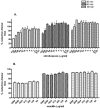Microplate Alamar blue assay for Staphylococcus epidermidis biofilm susceptibility testing
- PMID: 15980327
- PMCID: PMC1168683
- DOI: 10.1128/AAC.49.7.2612-2617.2005
Microplate Alamar blue assay for Staphylococcus epidermidis biofilm susceptibility testing
Abstract
Biofilms are at the root of many infections largely because they are much more antibiotic resistant than their planktonic counterparts. Antibiotics that target the biofilm phenotype are desperately needed, but there is still no standard method to assess biofilm drug susceptibility. Staphylococcus epidermidis ATCC 35984 biofilms treated with eight different approved antibiotics and five different experimental compounds were exposed to the oxidation reduction indicator Alamar blue for 60 min, and reduction relative to untreated controls was determined visually and spectrophotometrically. The minimum biofilm inhibitory concentration was defined as < or = 50% reduction and a purplish well 60 min after the addition of Alamar blue. All of the approved antibiotics had biofilm MICs (MBICs) of >512 microg/ml (most >4,096 microg/ml), and four of the experimental compounds had MBICs of < or = 128 microg/ml. The experimental aaptamine derivative hystatin 3 was used to correlate Alamar blue reduction with 2,3-bis(2-methoxy-4-nitro-5-sulfophenyl)-2H-tetrazolium-5-carboxanilide (XTT) reduction and viable counts (CFU/ml) for S. epidermidis ATCC 35984, ATCC 12228, and two clinical isolates. For all four strains, Alamar blue results correlated well with XTT (r = 0.83 to 0.97) and with CFU/ml results (r = 0.85 to 0.94). Alamar blue's stability and lack of toxicity allowed CFU/ml to be determined from the same wells as Alamar blue absorbances. If the described method of microplate Alamar blue biofilm susceptibility testing, which is simple, reproducible, cost-effective, nontoxic, and amenable to high throughput, is applicable to other important biofilm forming species, it should greatly facilitate the discovery of biofilm specific agents.
Figures




Similar articles
-
Application of a high throughput Alamar blue biofilm susceptibility assay to Staphylococcus aureus biofilms.Ann Clin Microbiol Antimicrob. 2009 Oct 27;8:28. doi: 10.1186/1476-0711-8-28. Ann Clin Microbiol Antimicrob. 2009. PMID: 19860905 Free PMC article.
-
Microplate Alamar blue assay for susceptibility testing of Candida albicans biofilms.Med Mycol. 2007 Nov;45(7):603-7. doi: 10.1080/13693780701581458. Med Mycol. 2007. PMID: 17885957
-
High in vitro antimicrobial activity of synthetic antimicrobial peptidomimetics against staphylococcal biofilms.J Antimicrob Chemother. 2009 Jan;63(1):136-45. doi: 10.1093/jac/dkn464. Epub 2008 Nov 14. J Antimicrob Chemother. 2009. PMID: 19010828
-
Antibiofilm activity of three Actinomycete strains against Staphylococcus epidermidis.Lett Appl Microbiol. 2019 Jan;68(1):73-80. doi: 10.1111/lam.13087. Epub 2018 Nov 22. Lett Appl Microbiol. 2019. PMID: 30338533 Review.
-
How Biofilms Evade Host Defenses.Microbiol Spectr. 2015 Jun;3(3). doi: 10.1128/microbiolspec.MB-0012-2014. Microbiol Spectr. 2015. PMID: 26185085 Review.
Cited by
-
Functionalization of titanium with chitosan via silanation: evaluation of biological and mechanical performances.PLoS One. 2012;7(7):e39367. doi: 10.1371/journal.pone.0039367. Epub 2012 Jul 31. PLoS One. 2012. PMID: 22859940 Free PMC article.
-
The intra-host evolutionary landscape and pathoadaptation of persistent Staphylococcus aureus in chronic rhinosinusitis.Microb Genom. 2023 Nov;9(11):001128. doi: 10.1099/mgen.0.001128. Microb Genom. 2023. PMID: 38010322 Free PMC article.
-
In-vitro effects of different hyaluronic acids on periodontal biofilm-immune cell interaction.Front Cell Infect Microbiol. 2024 Jun 13;14:1414861. doi: 10.3389/fcimb.2024.1414861. eCollection 2024. Front Cell Infect Microbiol. 2024. PMID: 38938883 Free PMC article.
-
Reduction of methicillin-resistant Staphylococcus aureus biofilm growth and development using arctic berry extracts.Front Cell Infect Microbiol. 2023 Jun 23;13:1176755. doi: 10.3389/fcimb.2023.1176755. eCollection 2023. Front Cell Infect Microbiol. 2023. PMID: 37424779 Free PMC article.
-
Pellicle Modification with Casein and Mucin Does Not Promote In Vitro Bacterial Biofilm Formation.Oral Health Prev Dent. 2020 Jul 4;18(3):475-483. doi: 10.3290/j.ohpd.a43351. Oral Health Prev Dent. 2020. PMID: 32515418 Free PMC article.
References
-
- Adam, B., G. S. Baillie, and L. J. Douglas. 2002. Mixed species biofilms of Candida albicans and Staphylococcus epidermidis. J. Med. Microbiol. 51:344-349. - PubMed
-
- Amorena, B., E. Gracia, M. Monzón, J. Leiva, C. Oteiza, M. Pérez, J.-L. Alabart, and J. Hernández-Yago. 1999. Antibiotic susceptibility assay for Staphylococcus aureus in biofilms developed in vitro. J. Antimicrob. Chemother. 44:43-55. - PubMed
-
- Back, S. A., R. Khan, X. Gan, P. A. Rosenberg, and J. J. Volpe. 1999. A new alamar blue viability assay to rapidly quantify oligodendrocyte death. J. Neurosci. Methods 91:47-54. - PubMed
-
- Baillie, G. S., and L. J. Douglas. 1999. Candida biofilms and their susceptibility to antifungal agents. Methods Enzymol. 310:644-657. - PubMed
Publication types
MeSH terms
Substances
LinkOut - more resources
Full Text Sources
Other Literature Sources
Medical
Molecular Biology Databases
Miscellaneous

